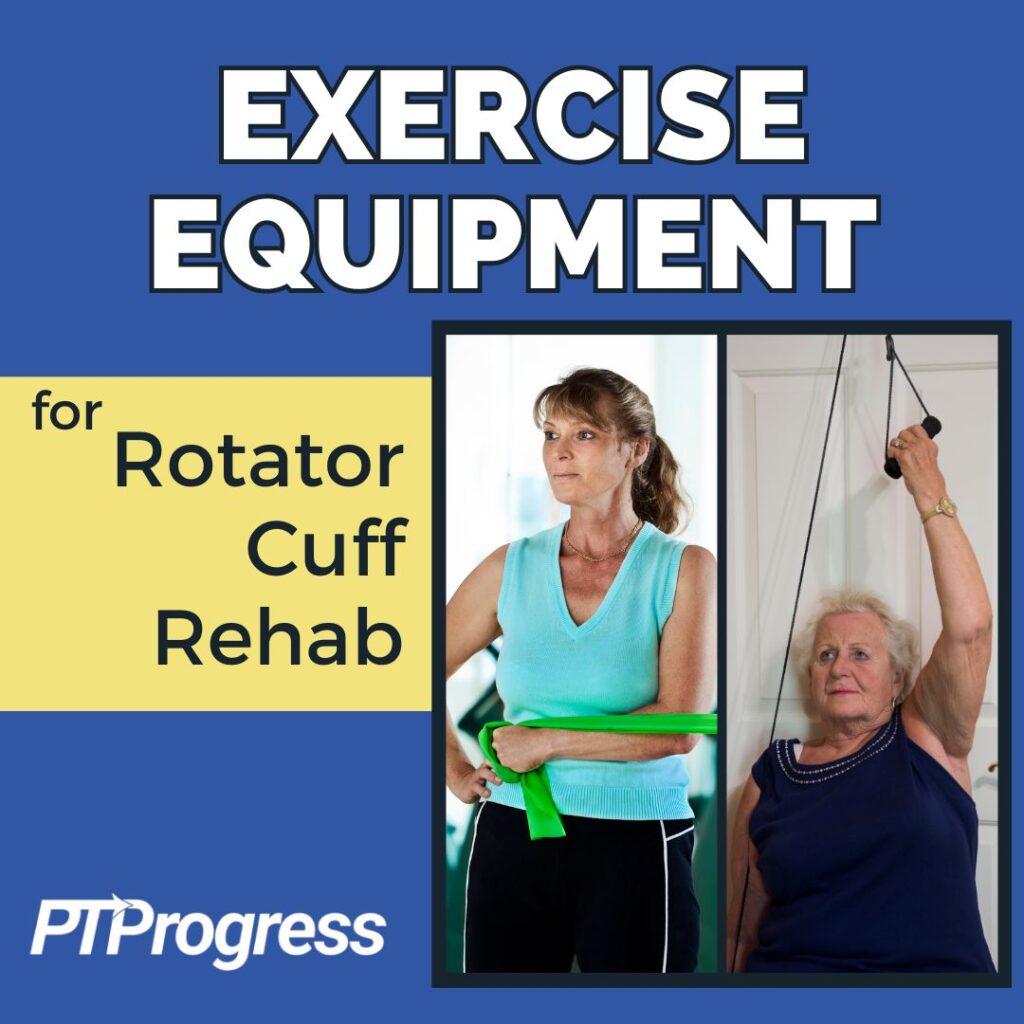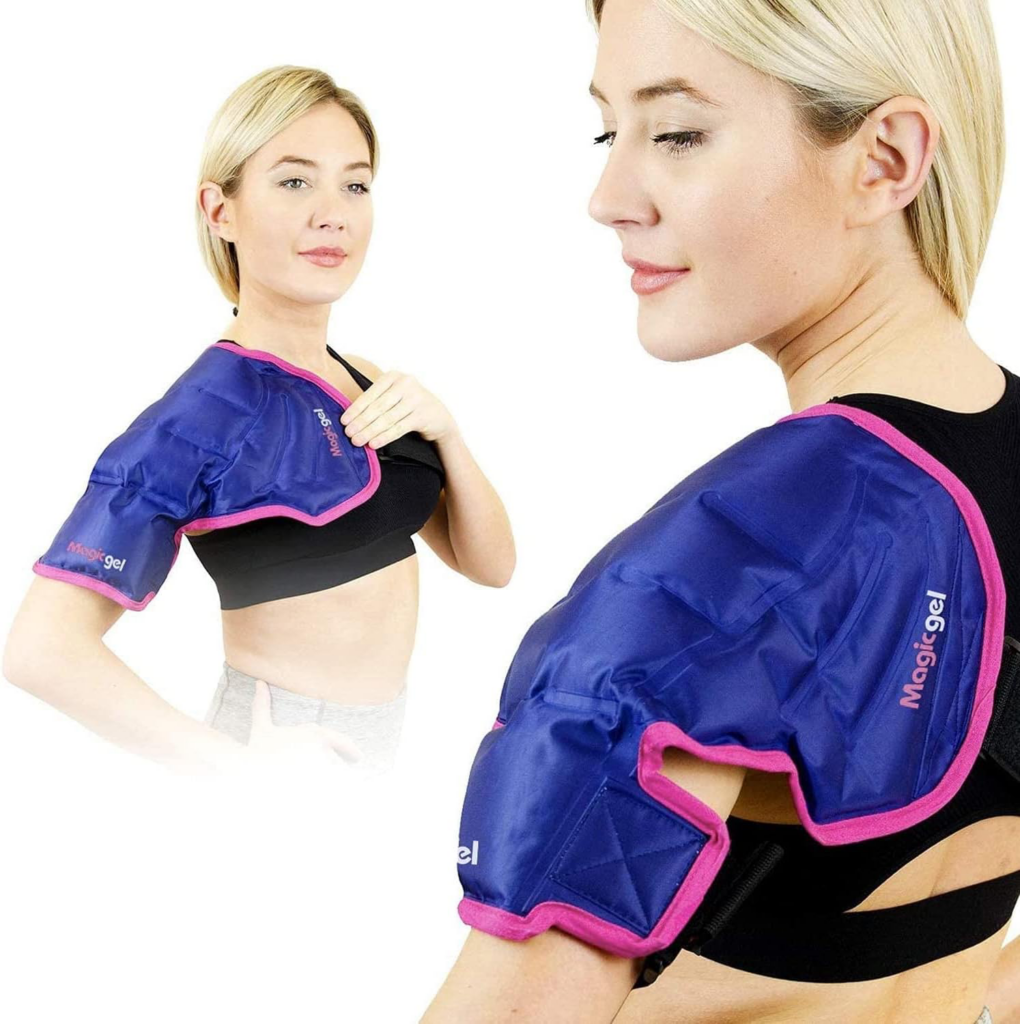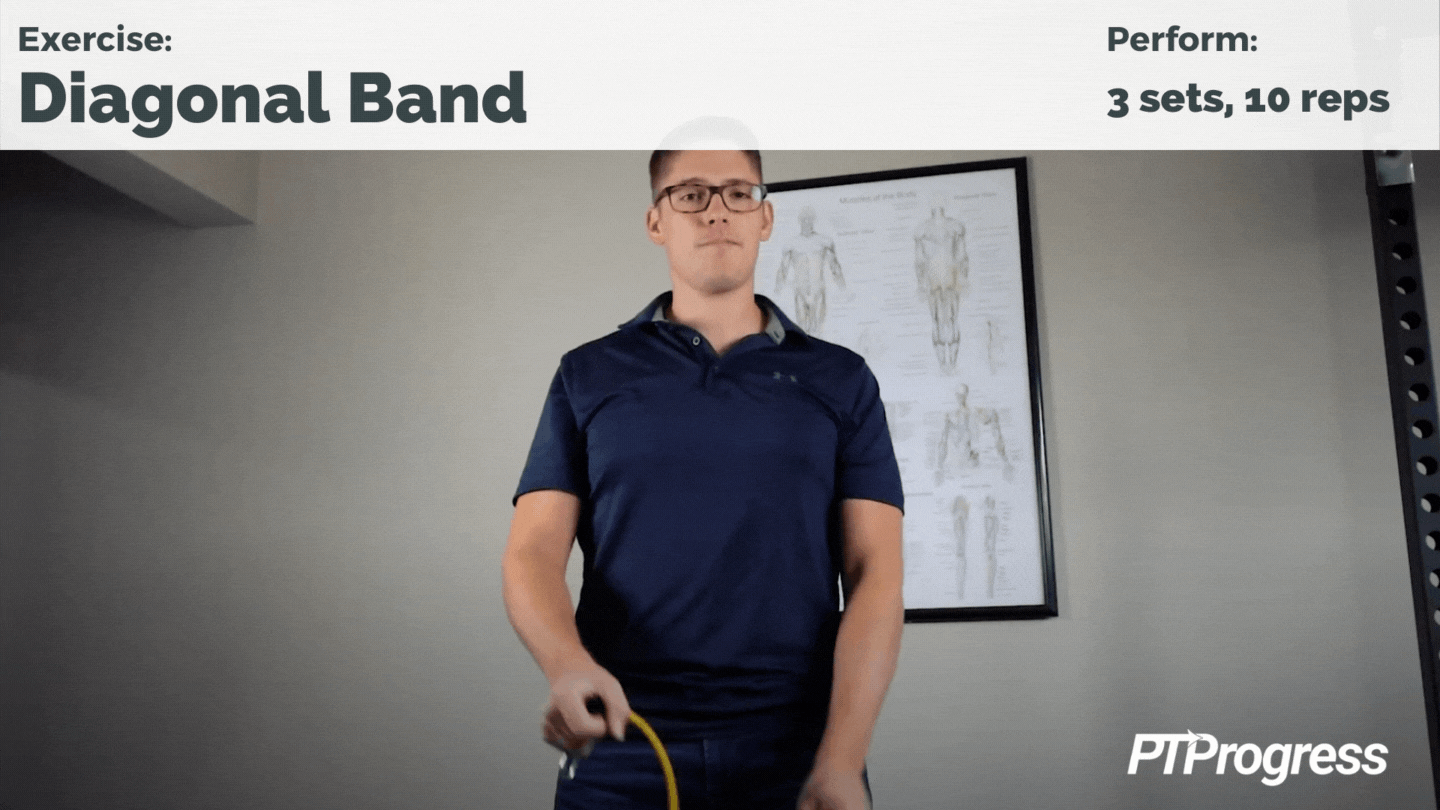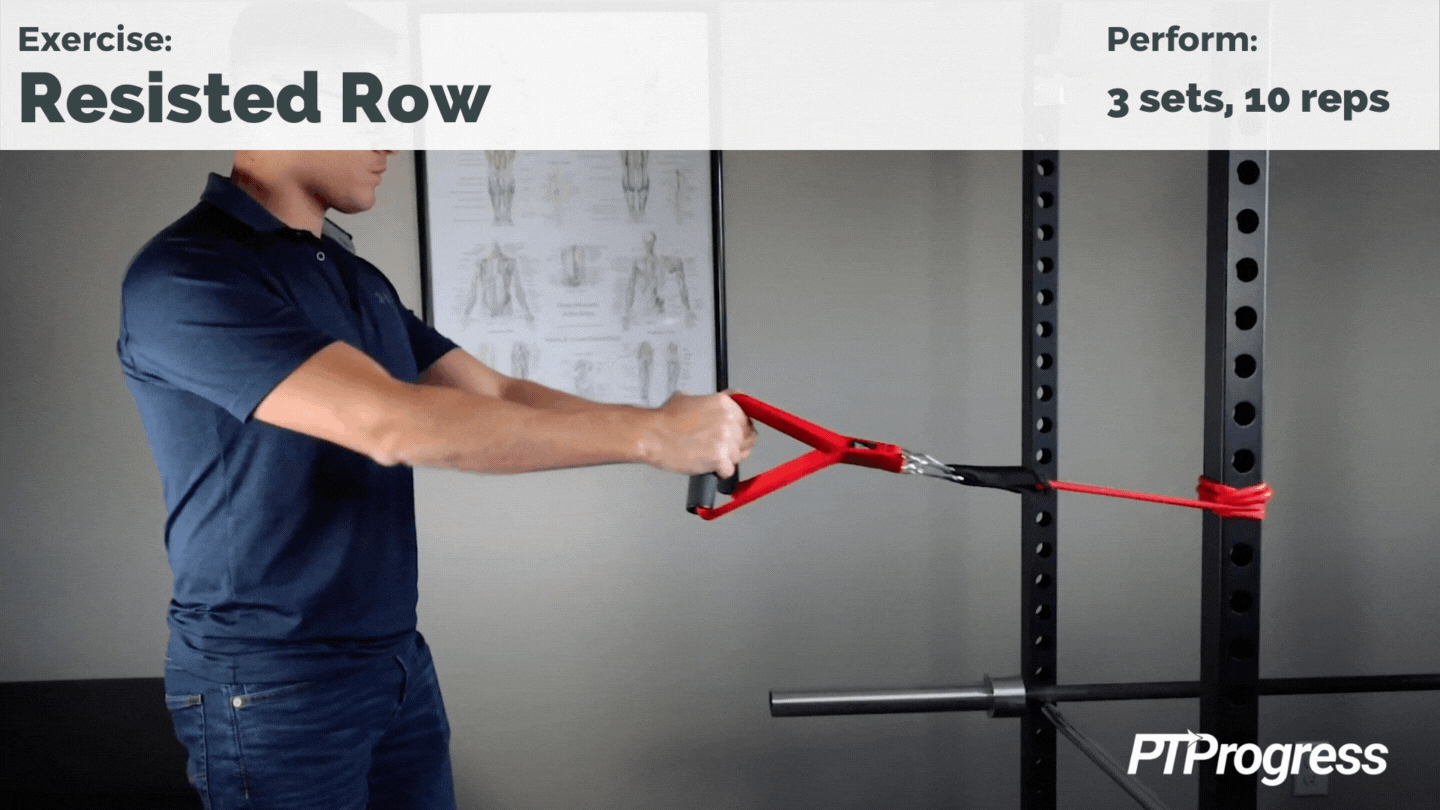
Do you have a surgery looming for your torn rotator cuff? You may be wondering whether you’re properly equipped for the recovery process; you’ll need more than a sling to rehabilitate your shoulder. So keep reading for my recommendations as a physical therapist on exercise equipment for rotator cuff surgery.
Rotator Cuff Surgery Overview
A serious tear in your rotator cuff could require surgery, especially if non-surgical treatment hasn’t helped. Rotator cuff surgery is a same-day procedure that will repair the torn tendon and reattach it to bone. Although the surgery itself is quick, your recovery could stretch out over several months. You’ll likely need to wear a sling for about 6 weeks after surgery, and during that time you won’t be able to raise your arm above your head or behind your back without assistance. You may not regain full use of your shoulder until 9–12 months after your surgery.
So what can you do? Physical therapy, of course! To facilitate the rehab process, you will likely go through 6–8 weeks of physical therapy, designed to help you manage pain, restore strength, and gain stability in your surgical shoulder. You can double your PT efforts by keeping up a routine at home, using the following exercise equipment for rotator cuff surgery.
Equipment for Rotator Cuff Surgery: Weeks 1–7
Early on after your rotator cuff surgery, your priorities will be to manage pain, reduce stiffness, and gradually widen your range of motion. The equipment below can help you establish good habits at home and continue the momentum you achieve in the PT clinic.
1. Ice Pack

What: Check out the wearable Magic Gel Ice Pack, available for $22 on Amazon (buy more than one!). Another option is this easy-on shoulder wrap, which includes a freezable insert. For continuous cold therapy, consider the Polar Active Ice 3.0 ice machine on Amazon and select the shoulder wrap attachment.
Why: After surgery, an ice pack will be your best friend. You’ll spend a lot of time together—to the tune of 20 minutes every hour—to manage pain and swelling in your shoulder. By constricting your blood vessels, cold temperatures reduce swelling and numb your pain receptors, helping your muscles relax and heal faster.
How: The shoulder isn’t an easy joint to apply ice to, so I recommend wearing a shoulder ice pack or a shoulder wrap with an ice pack insert. Or you can opt for an ice machine with a shoulder pad attachment. The upside to an ice machine is that it will keep the pack continuously cold, without thawing, for the duration of your therapy, and you won’t need to allocate space in your freezer for your recovery period. The downside is the cost.
2. Overhead Pulley
What: This overhead pulley from Amazon is less than 20 bucks, but it has all the features of the pulley you’ll use in the clinic: comfortable foam handles, lightweight construction, and two attachment options—bracket or strap—for securing over the door.
Why: Besides pain, when you come home from the hospital you’ll be dealing with a lot of stiffness. Using a device like an overhead pulley can help you safely introduce movement in your surgical shoulder by offloading the weight of your arm from the shoulder joint.
How: An overhead pulley is remarkably simple to use. Place a chair in front of a door, preferably a closet, that won’t get opened while you’re using it. Hang the pulley over the door and close it shut, then sit with your back to the door, holding the ends of the pulley in each hand. From here, use your good arm to pull down on the pulley and thereby raise your bad arm overhead, out to the side, or at a 45º angle, depending on what your PT has okayed. Practice these movements for a few minutes at a time, working on a gradual increase in your pain-free range of motion.
3. Dowel or Rod
What: You may already have a PT-ready dowel or rod in your house disguised as a broomstick or golf club. If not, a $5 dowel rod (3/4″ diameter, 36-48″ long) from Home Depot will work great!
Why: Early on in your recovery, your PT will give you exercises to do in the clinic and at home to help mobilize your stiff shoulder joint and increase its range of motion. A dowel or rod, when held with both hands, can help you use your good arm to leverage your surgical arm into therapeutic exercise with less pain and strain.
How: There are several PT exercises that call for a dowel or rod, so check with your PT. They may instruct you to lie on your back and hold the rod in both hands, with your hands shoulder-width apart. From here, you’d use the rod to assist your surgical arm into flexion (up-and-down), abduction (out to the side) and external rotation (turning out like a door on its hinge, with elbow bent). You can also perform press-ups with a rod: imagine you’re doing a bench press, but with the dowel instead of a barbell. Remember, always check with your PT before trying any of these exercises.
Exercise Equipment for Rotator Cuff: Weeks 8+
After the first 8 weeks or so of your physical therapy, your focus will shift towards building strength in your repaired shoulder. By now, you should be feeling less pain, enjoying a wider range of motion without that sling, and performing more challenging exercises in the clinic. The following tools will help you better replicate those workouts and incorporate more resistance in your at-home exercise.
4. Lightweight Dumbbells
What: A water bottle or can of soup may work in a pinch, but you’re better off with a set of light hand weights, such as these from Amazon, which cost less than $12 a pair. Look for 1-, 2-, or 3-pound options.
Why: Very light dumbbells—no more than 3 pounds—can challenge your shoulder muscles under rehabilitation. It may look silly to you, but even a 1-pound weight can transform how difficult a movement feels after rotator cuff surgery. With the approval of your PT and steady patience, light weights can help you transition into more moderate workouts when your shoulder is ready.
How: One way to use a light dumbbell is to “distract” your shoulder joint and weigh your arm down when you perform Pendulum Swings, demonstrated below. Such light weights can also provide a little extra resistance to exercises such as Sidelying External Rotation. To perform this move, lie on the side of your good arm and tuck a towel under the elbow of your surgical arm. Hold a weight in that hand and, keeping your elbow bent at 90º, rotate the weight up towards the ceiling without shifting your arm off the towel. Repeat for 10 reps a few times a day.
5. Resistance Bands
What: Resistance bands are a go-to piece of exercise equipment for rotator cuff surgery—as well as for many other surgeries and conditions. A high-quality brand of bands, like these from Bob and Brad, will withstand hundreds of workouts. A full set can replicate the wide range of weights you’d enjoy at a fitness center.
Why: Besides being compact and lightweight, resistance bands provide something dumbbells cannot: progressive resistance. This simply means that, as the band becomes more taut, it becomes harder to stretch, incorporating a dynamic element to your weight-lifting workouts. Plus, after surgery, you’ll appreciate being able to easily modify each shoulder exercise by simply slackening or choking up on the band.
How: Resistance bands will help you add progressive resistance to several rotator cuff exercises, including external rotation, internal rotation, shoulder flexion, and abduction. You can use the band on its own or anchor it to a sturdy post or inside a closed door to create more exercise options. Check with your PT for exact instructions and parameters.


6. Theraband Ball

What: This eye-catching piece of exercise equipment is just a squishy rubber ball about 9 inches in diameter. In the clinic we often use a Theraband ball to perform isometric exercises, but you can also use a rolled up towel instead, as I do in the demonstrations below.
Why: The plush give of a theraband ball is perfect for isometric exercise. Translating to “same length,” an isometric exercise involves contracting the muscle without lengthening or moving it. These contractions will help you strengthen the stabilizing muscles in your rotator cuff.
How: Your PT will give you specific instructions for each type of isometric hold, but almost all of them require a support structure, such as a wall, against which you’ll brace your arm to perform the contraction. Your objective isn’t to press a hole through the wall, but rather squeeze just enough to contract the muscle for 5–10 seconds before releasing and repeating. See below for some of the ways to perform isometric holds.
Exercise Equipment for Rotator Cuff Surgery: Final Thoughts
After a rotator cuff surgery, ensuring a swift recovery and healthy shoulder will require your daily attention. The best piece of equipment you can ready is your own commitment to consistency, which will affect your outcomes far more than any one fitness gadget. That being said, the equipment described above can help elevate your rehabilitation efforts, helping you replicate at home the good progress you make in PT.
For more resources on rotator cuff recovery, including what to expect after surgery, check out the rest of the blog!

